I want to talk a little bit this week about my favorite deck in the format: Solar Flare. I sort of chose to do so now because it’s a deck that I feel has fallen by the wayside but that is extremely powerful. In my opinion, Solar Flare is the best deck in the format, but people are using it wrong. I have a list that I’ve been very happy with in the past month or so, but it’s very different than normal Solar Flare lists. Thus, I’m going to deconstruct Solar Flare and then rebuild it, showcasing how I built the deck.
First, we start with the original list to take a look at what we are trying to replicate.
"Solar Flare by Paul Cheon"
- Creatures (11)
- 3 Angel of Despair
- 3 Court Hussar
- 1 Ink-Eyes, Servant of Oni
- 1 Kokusho, the Evening Star
- 1 Meloku the Clouded Mirror
- 2 Yosei, the Morning Star
- Spells (26)
- 3 Mortify
- 4 Remand
- 2 Persecute
- 3 Zombify
- 4 Compulsive Research
- 4 Wrath of God
- 2 Dimir Signet
- 4 Azorius Signet
- Lands (23)
- 1 Island
- 1 Plains
- 2 Swamp
- 1 Hallowed Fountain
- 1 Underground River
- 1 Watery Grave
- 2 Azorius Chancery
- 2 Caves of Koilos
- 2 Orzhov Basilica
- 2 Tendo Ice Bridge
- 3 Godless Shrine
- 1 Eiganjo Castle
- 1 Mikokoro, Center of the Sea
- 1 Minamo, School at Water's Edge
- 1 Miren, the Moaning Well
- 1 Shizo, Death's Storehouse
The sideboard isn’t relevant because it’s metagame-dependent. So, what are the important takeaways and strengths from the original deck?
- Solar Flare is built in a control shell. The deck is fundamentally a control deck that is able to use the graveyard as a resource.
- Solar Flare relies on both spells and permanents to control the board.
- Ink-Eyes is the only finisher present that does not have a very strong defensive component attached. Keiga, Kokusho, Meloku, Yosei, and Angel of Despair are all strong as defensive measures, in addition to being strong offensive measures.
I want to stress the importance of Takeaway 3 because that is where I feel a lot of deck-builders are making a huge mistake with this deck. One of the strengths of Solar Flare was the ability of its fatty suite to serve as a double-edged sword—defending the Solar Flare player when need be, then turning around and finishing off the opponent in very short order.
In reconstructing Solar Flare for the modern metagame, it is crucial that we replicate all of these strengths in order for the deck to be successful as a strategy. Solar Flare is an extremely powerful implementation of a more aggressive, tap-out control style, and that can definitely be brought to bear in the modern metagame.
The first order of business is to look at the modern control shell: U/B.
"U/B Control by Jeremy Neeman"
- Creatures (9)
- 1 Grave Titan
- 3 Consecrated Sphinx
- 4 Snapcaster Mage
- 1 Wurmcoil Engine
- Spells (24)
- 1 Geth's Verdict
- 1 Negate
- 2 Wring Flesh
- 3 Forbidden Alchemy
- 4 Dissipate
- 4 Doom Blade
- 4 Mana Leak
- 4 Think Twice
- 1 Black Sun's Zenith
- Lands (27)
- 6 Swamp
- 9 Island
- 2 Ghost Quarter
- 2 Nephalia Drownyard
- 4 Darkslick Shores
- 4 Drowned Catacomb
This is the basic control shell we’ll be modifying. So, let’s take a look at cards I don’t like in this style of deck.
Enemies #1 and #1a:
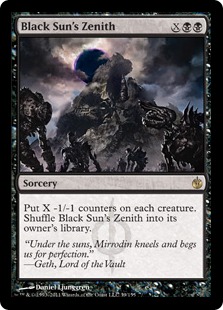
Frankly, this card sucks. It sucks really, really, really, really bad.
Day of Judgment: Look at your sweeper, now back to me, now back to your sweeper, now back to me. Sadly, it isn’t me, but if it stopped being a horribly mana-intensive steaming pile, it could seem like it’s me. Look down, now look up. Where are you? Facing down a Dungrove Elder you can’t kill. What’s that? It’s a Consecrated Sphinx drawing your opponent cards. Look again—all those creatures are dead. Anything is possible when your sweeper always costs 4 mana.
Day of Judgment: the sweeper your sweeper could be like.
Day of Judgment solves so many problems that it even allows us to remove some of the other cards I don’t like:
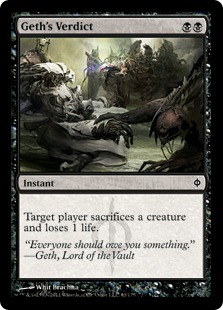 | 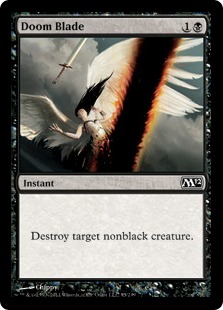 |
I’ll touch on Doom Blade later. However, if you rebuild Solar Flare along the basic principles I laid out, using the U/B control shell, you would probably come up with something like this:
"Solar Flare by Akira Asahara"
- Creatures (7)
- 1 Sun Titan
- 3 Consecrated Sphinx
- 3 Snapcaster Mage
- Planeswalkers (2)
- 2 Liliana of the Veil
- Spells (25)
- 3 Doom Blade
- 3 Think Twice
- 4 Dissipate
- 4 Forbidden Alchemy
- 4 Mana Leak
- 1 Unburial Rites
- 3 Day of Judgment
- 3 Oblivion Ring
- Lands (27)
- 3 Island
- 3 Plains
- 3 Swamp
- 1 Drowned Catacomb
- 2 Ghost Quarter
- 3 Glacial Fortress
- 4 Darkslick Shores
- 4 Isolated Chapel
- 4 Seachrome Coast
So, now we see a Solar Flare list that seems reasonable and that looks like a lot of the lists I’ve been seeing online these past few weeks. I really don’t like this list, however. First, let’s look at the spells. What don’t I like? Well, we’ll start with the carryover from the U/B control shell: Doom Blade.
What’s wrong with Doom Blade? The short answer is nothing. The long answer is that I feel that Solar Flare should have more diversified spot removal. Black has both Dismember and Go for the Throat available to it, so why are we running just four Doom Blades? The lack of any Go for the Throat is especially egregious to me. In the vast majority of situations, these cards are identical. Doom Blade deals with Wurmcoil Engine (which you really don’t want to kill), while Go for the Throat deals with Grave Titan (which you really do want to kill). Doom Blade is also good against Tempered Steel, so that is a consideration as well.
So, why do I want Dismember when it doesn’t deal with Titans? The reason is simple: It costs 1 mana. The ability to have a Dismember on turn one can slow down so many decks, from mono-Red to Pod to Tempered Steel. Just as an example, three of the deck’s biggest weaknesses are turn-two Stormblood Berserker, Mirran Crusader, and Dungrove Elder. If played successfully on turn two, all of these creatures can do enough damage that the mid- to late-game follow-up will finish the job. However, if they don’t hit on turn two, they’re significantly less threating. You have Mana Leak on the play or draw, Dissipate on the play, and Day of Judgment to handle them. Dismember stops all three from hitting on turn two. Dismember is extremely strong in the early game, and it retains a good amount of functionality in the midgame and late game. I see no reason to not have access to it.
What’s the cost of diversifying our Black removal? We might be stuck with the wrong removal at the wrong time. Well, I contend that this isn’t really going to be an issue. Why? Oblivion Ring. Oblivion Ring will smooth out our spot-removal necessities and allow us to use our other removal when it will be most effective. Oblivion Ring is the glue that will hold our removal suite together.
All right, let’s go on to the next set of things I don’t like:
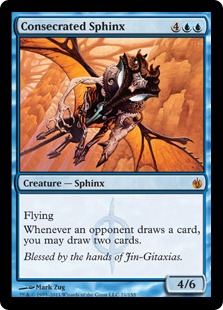 | 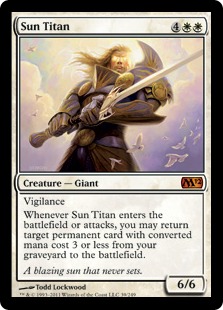 |
Remember what I said about the fat being two-way threats? Neither of these is a two-way threat. Consecrated Sphinx, while strong, does very little to actually affect the board. All it has is its body, which isn’t particularly impressive. A 4/6 flyer can be beaten a number of ways. Sure, after you draw a bunch of cards, you are likely to have a bunch of answers, but you might not be alive then. Consecrated Sphinx is a huge trap for Solar Flare players. It’s right for U/B control, which simply wants more cards, but in Solar Flare, which is trying to be an aggressive control deck, the card doesn’t have a place.
Now we move on to a very popular Solar Flare threat: Sun Titan. Let me ask you: What are you doing with Sun Titan? Once again, the 6/6 body part is nice, but it’s really just that: a 6/6. The original Solar Flare had a bunch of 5/5 flyers that were capable of far more; Kokusho could gain its controller life, pulling him out of burn range; Keiga could steal creatures; Yosei could buy you an entire turn; and Angel of Despair came with a Vindicate attached.
I played Sun Titan a lot a year ago. My older readers may remember me writing at least one, if not more, articles advocating that people play Sun Titan. So, what’s my beef with this guy now? Why did I love him a year ago and not now? Well, let me ask you a question: What does Sun Titan come with?
The answer, realistically, is a land. That is what you are getting off the trigger. Oblivion Ring is not happening. If you get Snapcaster Mage, you have to have even more mana to flash back whatever else you are getting. Liliana of the Veil is quite awesome, but there are only two of them in your deck. So, Sun Titan will usually come with a land. Now, if this were coming with a variety of answers and threats attached, I would like it, but it isn’t. It’s coming with a land. That, friends, is not good enough anymore. A year ago, when that land was Tectonic Edge, it was more than enough. Now it isn’t. Why? Because Ghost Quarter is not Tectonic Edge. See, a year ago, Tectonic Edge was good against pretty much everyone. I Tec-Edged everything, ranging from Valakut, the Molten Pinnacle to Sunpetal Grove. Ghost Quarter is really only good against Kessig Wolf Run, Inkmoth Nexus, and Moorland Haunt. So, the difference in applicability is one thing, but the other big thing is that Ghost Quarter still gives your opponent a land. One of the biggest strengths of Tectonic Edge was the ability to generate openings in the control mirror by blowing up a land or two at the end of the opponent’s turn. Ghost Quarter can’t do that.
Remember that the basic principle of Solar Flare is to have creatures that serve both offensive and defensive roles. So, if we aren’t running Consecrated Sphinx and Sun Titan, what are we running?
Well, we are fortunate enough to have a number of solid two-way creatures at the moment. They are headlined by these three beauties:
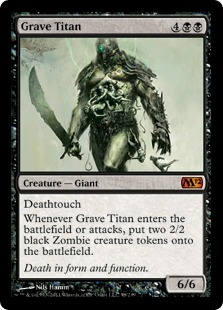 | 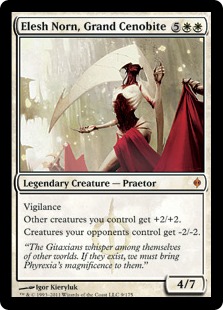 | 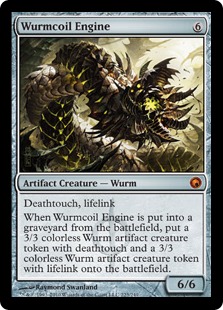 |
Let’s take a look at how all of these creatures function in the desired offensive/defensive paradigm:
Grave Titan
Offensive: It puts 10 power on the board. ’Nuff said.
Defensive: It puts three creatures on the board, making it a threat that is resilient to spot removal and able to buy a significant amount of time on the ground, if not outright halt a ground-based assault.
Elesh Norn, Grand Cenobite
Offensive: She gives +2/+2 to friendly creatures lying around, including random Zombies left over from Grave Titan and a certain 2/1 Human Wizard. Combined with a 4/7 body, Elesh Norn is quite capable of putting some hurt on.
Defensive: Are you kidding me? -2/-2 to the opponent’s entire team permanently? It deals with this deck’s two biggest problems: Inkmoth Nexus and Moorland Haunt. In addition, there are some decks that basically cannot win if you put an Elesh Norn in play and protect it (Tokens, I’m looking at you). She will also eliminate a lot of cannon-fodder and allow you to deal with threats like Dungrove Elder with Liliana of the Veil.
Wurmcoil Engine
Offensive: It’s an extremely resilient 6/6 threat.
Defensive: Lifelink. This card is a big giant stop sign for aggro decks.
Honorable Mention
Massacre Wurm and Frost Titan. Both of these cards are capable in both offensive and defensive roles. They are capable of locking down boards and attacking for hefty chunks of damage while doing it. If the metagame calls for it, it would be unwise to forget these boys on the sidelines.
So, our threats should be Elesh Norn, Wurmcoil, and Grave Titan. The numbers we can play with later. Let’s move on to the second of three aspects of Asahara’s list that I don’t like:
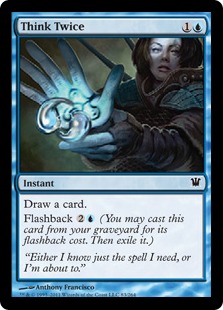
Solar Flare’s mana is, in one word, awful (here is Brian Kibler’s article on the subject on SCG Premium). This doesn’t help it. Solar Flare is fat around the middle. The vast majority of its spells fall in the 3-to-6-mana range. This card only exacerbates the issue, and it really isn’t powerful enough to warrant it. I also feel that it isn’t doing the right thing for Solar Flare. See, Solar Flare, in general, does not need more cards. The deck has a lot of high-quality, useful cards available to it and can usually make very effective use of its cards. What Solar Flare needs is the right card. Think Twice is very bad at finding specific cards, and only marginally better at getting you more cards (you are paying 5 mana for an extra card, after all). Thus, I really am not a fan of Think Twice. What I am a fan of is this card:
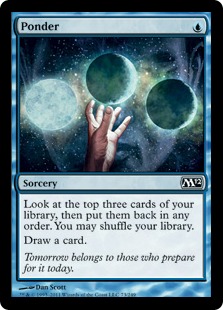
I was onto Ponder about a month ago, but really didn’t feel like writing about Standard, so I left the Solar Flare mages and their Think Twices alone. Sadly, Alex Shearer stole some of my thunder with this article, but Ponder is absolutely incredible at digging for specific cards, which is exactly what Solar Flare wants to do. It is, in addition, only 1 mana, which helps smooth out the way Solar Flare is able to use its mana. Unlike Think Twice, Ponder is awesome to flash back with Snapcaster Mage and quite good even when you cast it only once. All in all, Ponder is far superior for Solar Flare. Think Twice is wrong; Ponder is right.
Now, the third and final thing I don’t like about the way most people build Solar Flare:
These lands . . .
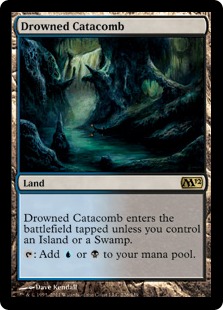 | 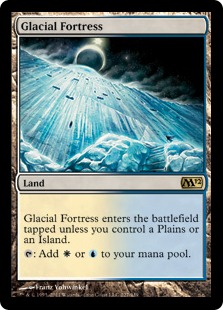 |
. . . are better than these lands.
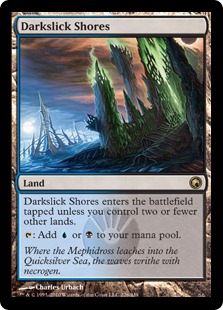 | 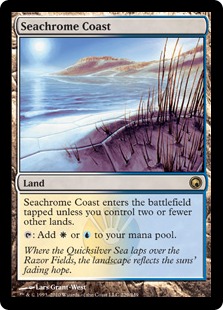 |
Now, why would I say that? The answer is simple: Drowned Catacomb and Glacial Fortress come into play untapped when it matters. See, people have this misconception that the crucial turns for a control deck’s mana development are turns one through three. This is, in fact, not the case. As long as Wrath of God or Day of Judgment exists, the crucial turns for a control deck’s mana development are actually four through seven. Why? Because Wrath of God matters that much.
Just as an example, Andrew Cuneo went undefeated Day 1 at Worlds (coverage here) with a W/U list that leans very heavily on Day of Judgment. Look at that deck—it really has nothing else. So, how does he deal with all of those threats that present themselves early? The 4-mana sorcery is enough.
This is the iron rule of control decks that have 4-mana Wraths: Your fourth land cannot, under any circumstances, come into play tapped. This is because Wrath of God and its new best friend, Day of Judgment, solve so many problems for you, simply by being there on turn four. So, that is strike one against Darkslick Shores and Seachrome Coast. They don’t come in untapped on turn four.
What’s strike two? They don’t come in untapped after that, either. You see, it isn’t getting to the 4-mana Wrath that is typically the problem for control decks. It is surviving the onslaught after that. Why? Because at this point, the control deck needs to do two things: It needs to develop its own game plan and board while still defending against its opponent. This means that after this point, the control deck’s mana is actually strained. From turns one to four, the control deck can simply devote all its mana to defense, and that is fine. Sure, it may lose a little bit here and there, but when you are only doing one thing, you can afford the loss. After turn four, the control deck needs to kick into gear, and that means that its mana becomes particularly strained. Darkslick Shores and Seachrome Coast do not help that issue. They actually constrain the control deck’s mana when it hurts the most to do so.
So, what’s strike three? Seachrome Coast and Darkslick Shores do their thing when it doesn’t matter. The first three turns are relatively unimportant for a control deck. As long as you are able to somewhat interact with your opponent, it isn’t a huge deal—especially when you can catch everything with Wrath of God. See, you don’t actually need to hit turn-two Mana Leak or Doom Blade and turn-three Oblivion Ring or Dissipate. Hitting one or the other is usually fine, especially if you have the ability to follow it up with turn-four Wrath of God. So, it doesn’t really matter if your second or third land comes in tapped (both can be disastrous, but not always). Thus, Seachrome Coast and Darkslick Shores help you most when you don’t really need it.
As they say: Three strikes and you’re out. The correct way to build Solar Flare’s mana base is not to use Drowned Catacomb and Glacial Fortress to supplement Darkslick Shores and Seachrome Coast, but to use them the other way around. Thus, start four of each M10 dual, and supplement with the Scars duals.
Well, with that, I’ve finally arrived at my deck list.
"Solar Flare by Chingsung Chang"
- Creatures (8)
- 2 Grave Titan
- 4 Snapcaster Mage
- 1 Wurmcoil Engine
- 1 Elesh Norn, Grand Cenobite
- Planeswalkers (2)
- 2 Liliana of the Veil
- Spells (24)
- 1 Dismember
- 1 Doom Blade
- 1 Go for the Throat
- 2 Dissipate
- 4 Forbidden Alchemy
- 4 Mana Leak
- 2 Unburial Rites
- 3 Day of Judgment
- 4 Ponder
- 2 Oblivion Ring
- Lands (27)
- 2 Plains
- 2 Swamp
- 5 Island
- 2 Darkslick Shores
- 2 Seachrome Coast
- 3 Ghost Quarter
- 3 Isolated Chapel
- 4 Drowned Catacomb
- 4 Glacial Fortress
- Sideboard (15)
- 4 Delver of Secrets
- 1 Wurmcoil Engine
- 1 Dismember
- 1 Go for the Throat
- 2 Dissipate
- 2 Negate
- 1 Day of Judgment
- 3 Timely Reinforcements
I wouldn’t really touch the main deck. If three Ghost Quarters bothers you, you can cut one for another basic land or an Isolated Chapel, but I think that access to two is very good. The sideboard is currently in flux because I am trying a Delver of Secrets plan against U/B. I’m not sure that I like it, but it is an interesting angle of attack. The Negate and Delver of Secrets in my current sideboard are the flexible slots. The other nine I think are fairly solid for this metagame. I was ’boarding extra counterspells and the four Delvers for the control matchups—U/B and the mirror. There are other plans as well, but that’s the one I’m currently trying out.
Chingsung Chang
Conelead most everywhere and on MTGO
Khan32k5 at gmail dot com
























